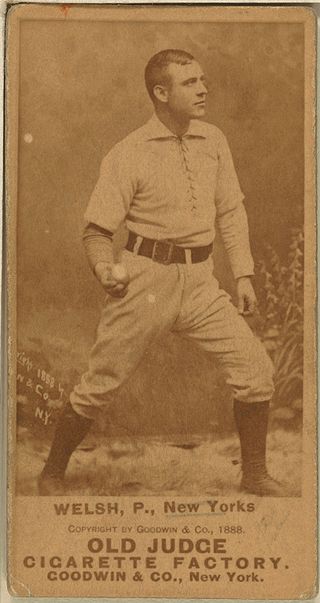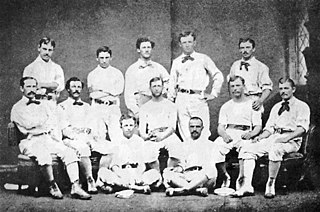Related Research Articles
The Players' National League of Professional Base Ball Clubs, popularly known as the Players' League (PL), was a short-lived but star-studded professional American baseball league of the 19th century. The PL was formed by the Brotherhood of Professional Base Ball Players in November 1889, after a dispute over pay with the National League (NL) and American Association (AA). The NL had implemented a reserve clause in 1879, which limited the ability of players to negotiate across teams for their salaries; both the AA and NL had passed a salary cap of US$2,000 per player in 1885, equivalent to $56,190 in 2022; the owners of the NL had agreed to remove the salary cap in 1887 but failed to do so. Major League Baseball (MLB) considers the PL a "major" league for official statistical purposes.

The Worcester Worcesters were a 19th-century Major League Baseball team from 1880 to 1882 in the National League. The team is referred to, at times, as the Brown Stockings or the Ruby Legs; however, no contemporary sources from the time exist that support the use of either name. The team played their home games at the Worcester Driving Park Grounds in the Worcester Agricultural Fairgrounds, located south of Highland Street between Sever Street and Russell Street in Worcester, Massachusetts.

Michael Francis Welch, nicknamed "Smiling Mickey", was a Major League Baseball pitcher. He stood 5 feet 8 inches (1.73 m) tall and weighed 160 pounds (73 kg). He was the third pitcher to accumulate 300 career victories. Welch was born in Brooklyn, New York, and played 13 seasons in the major leagues, three with the Troy Trojans, and 10 with the New York Gothams/Giants. He was very successful with an effective curveball, a change of pace, and a version of the screwball. During his 13 major league seasons, he posted 20 or more wins nine times, seven in succession.
Haymakers' Grounds was a baseball grounds in Lansingburgh, New York, which is now part of Troy, New York. It was home to the Troy Haymakers of the National Association from 1871 to 1872 and home to the Troy Trojans of the National League from 1880 to 1881.
Union Base-Ball Grounds was a baseball park located in Chicago. The park was "very visibly downtown", its small block bounded on the west by Michigan Avenue, on the north by Randolph Street, and on the east by railroad tracks and the lake shore, which was then much closer than it is today. The site is now part of Millennium Park.

The Mutual Base Ball Club of New York was a leading American baseball club almost throughout its 20-year history. It was established during 1857, the year of the first baseball convention, just too late to be a founding member of the National Association of Base Ball Players. It was a charter member of both the first professional league in 1871 and the National League in 1876.

The Athletic Base Ball Club of Philadelphia was a prominent National Association, and later National League, professional baseball team that played in the second half of the 19th century.
The Capitoline Grounds, also known as Capitoline Skating Lake and Base Ball Ground, was a baseball park located in Brooklyn, New York, from 1864 to 1880. It was built to rival nearby Union Grounds, also in Brooklyn. The park hosted local amateur teams in its early history, but later hosted professional and semi-professional games. The park's only season as the home field for an all-professional team occurred in 1872 when the Brooklyn Atlantics joined the National Association of Professional Base Ball Players. The park was flooded during the winter and used as an ice skating park. The grounds were used by local high schools and colleges as well, to play American football games, and ice rink football matches.
The following are the baseball events of the year 1880 throughout the world.
The following are the baseball events of the years 1845 to 1868 throughout the world.

The Troy Trojans were a Major League Baseball team in the National League for four seasons from 1879 to 1882. Their home games were played at Putnam Grounds (1879) and Haymakers' Grounds (1880–1881) in the upstate New York city of Troy, and at Troy Ball Clubs Grounds (1882) across the Hudson in Watervliet, or "West Troy" as it was known at the time.
Patrick A. McManus was a Major League Baseball pitcher during part of the 1879 season. He was a native of Ireland.

Eckford of Brooklyn, or simply Eckford, was an American baseball club from 1855 to 1872. When the Union Grounds opened on May 15, 1862 for baseball in Williamsburg, Brooklyn, it became the first enclosed baseball grounds in America. Three clubs called the field on the corner of Marcy Avenue and Rutledge Street home; however, the Eckford of Brooklyn were the most famous tenant. They played more games than any other club that year (7) and won the "national" championship, repeating the feat in 1863. During that two year period, the Eckfords won 22 straight matches which was the longest undefeated and untied streak to date. In the late 1860s, they were one of the pioneering professional clubs, although probably second to Mutual of New York at the home park. In its final season, Eckford entered the second championship of the National Association, the first professional baseball league in America, so it is considered a major league club by those who count the NA as a major league.

Fredrick Elroy Goldsmith was a right-handed pitcher in 19th-century professional baseball in both the U.S. and Canada. In his prime, Goldsmith was six-foot-one-inch tall and weighed 195 pounds.
The Troy Haymakers were an American professional baseball team.
The Washington Nationals of the 1870s were the first important baseball club in the capital city of the United States. They competed briefly in the National Association of Professional Base Ball Players, the first fully-professional sports league in baseball. The Nationals are considered a major-league team by those who count the National Association as a major league. Several other baseball clubs based in Washington, D.C., have also used the historic name Nationals.
The Lincoln Park Grounds, commonly known as Union Grounds, was a former baseball park, part of Lincoln Park, located in Cincinnati, Ohio. The Grounds were built for the Union Cricket Club in 1856; they "were used for cricket and baseball in the summer and were flooded for skating in the winter." In 1865 Harry Wright became the professional of the Cincinnati Cricket Club, which also used the grounds, and the next year Aaron Champion, president of the new Cincinnati Base Ball Club, "approached Wright to propose a limited use of the grounds if the CBBC and Live Oaks club would put in $2000 each to revamp the Lincoln Park Grounds."
A year later the [Red Stockings] leased the grounds of the Union Cricket Club for its home tilts. Most club members referred to the field as the Union Grounds, although it also was known as the Union Cricket Club Grounds and the Lincoln Park Grounds, given the fact that the eight-acre, fenced grounds were located in a small park behind Lincoln Park in Cincinnati, near the Union Terminal. It was a twenty-minute ride by streetcar to the Union Grounds from the heart of downtown Cincinnati. Aaron Champion ordered that approximately $10,000 worth of improvements be made to the home grounds for the 1867 season, including grading and sodding of the field and building of a new clubhouse and stands.
References
- ↑ James L. Terry (20 March 2002). Long Before the Dodgers: Baseball in Brooklyn, 1855-1884. McFarland. pp. 33–. ISBN 978-0-7864-1229-7.
- ↑ Jeffrey Michael Laing (30 September 2015). The Haymakers, Unions and Trojans of Troy, New York: Big-Time Baseball in the Collar City, 1860-1883. McFarland. p. 227. ISBN 978-0-7864-9493-4.